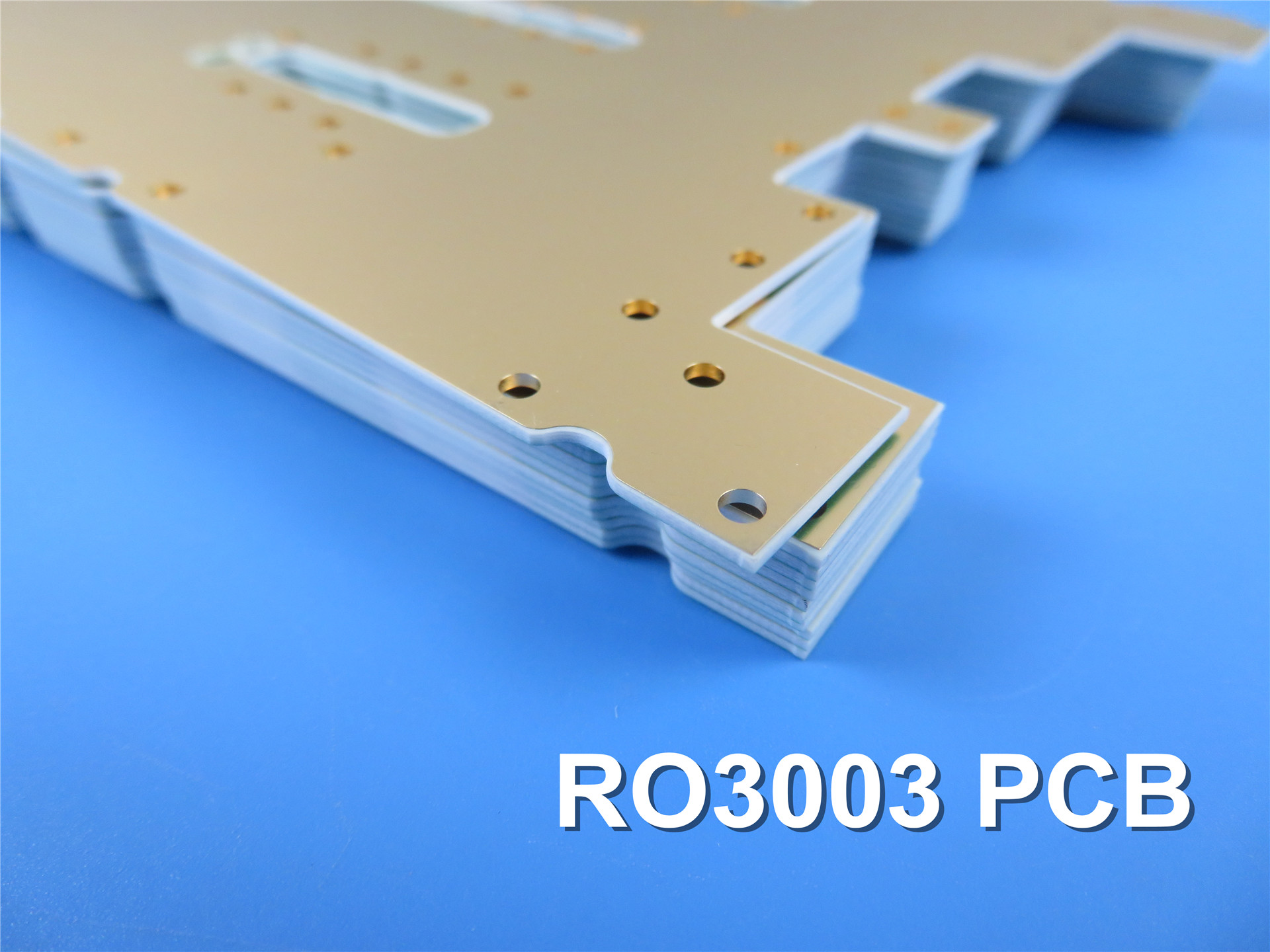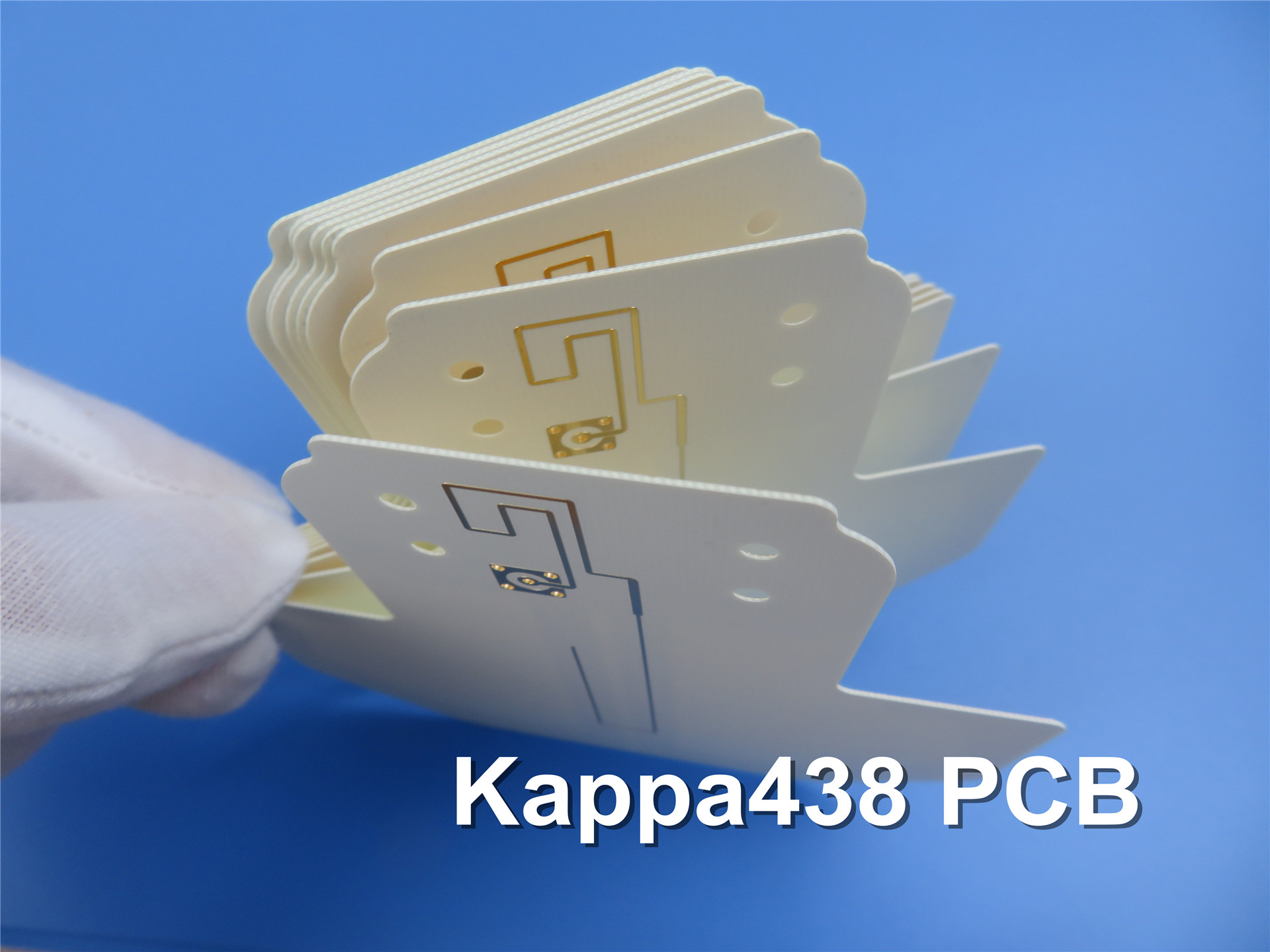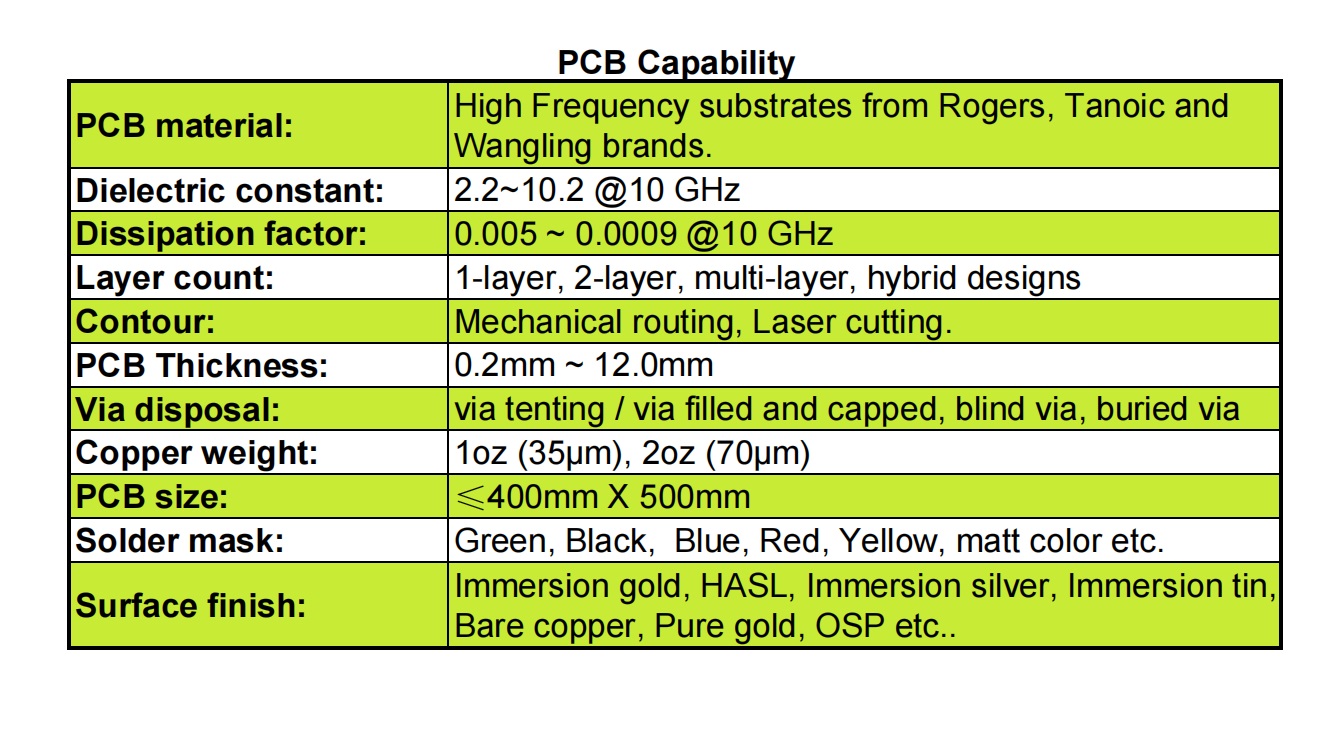What circuit boards
do we do in RF Field?
Founded
in 2003, Bicheng PCB has been an established high frequency PCB supplier and
exporter in Shenzhen China, servicing cellular base station antenna, high
frequency passive components, microstrip line and band line circuit, millimeter
wave equipment, radar systems, digital radio frequency antenna etc for more
than 19 years.
Our high frequency PCBs are mainly built on 3 high frequency material brands:
Rogers Corporation, Taconic and China Wangling. Dielectric constant ranges from
2.2 to 10.2 etc.

Now
I list the most materials that we used, but not limited to. There are 3
principal brands and each brand has different series products.
As
we know, Rogers starts from its RO3000 series, RO4000 series, RT/duroid 5000
series and RT/duroid 6000 series. Subsequently, AD series, DiClad, CuClad and
TMM series come into the line card.
Taconic,
There’s TLX series, RF series and TLY series, such as base station antenna
(TLX-8, RF-30), satellite communication terminal antenna (RF-10), high power
and miniaturized amplifier (RF-35, RF-60), millimeter wave RF backplane
(TLY-5Z), etc.
Wangling,
a 38-year-brand factory, alternative and competitive RF material manufacturer
in many areas of aerospace and aviation, satellite communication, navigation
and radar, electronic countermeasure, 4G and 5G communication etc. F4B (PTFE)
and composite dielectric substrates are the main product lines.
Next,
we can see the detailed properties of each material.
RO3000
Series laminates are ceramic-filled PTFE composites with consistent mechanical
properties and electrical stability, regardless of what DK value selected. This
allows the designer to develop multi-layer board designs that use different
dielectric constant materials for individual layers, without encountering
war-page or reliability problems. Additionally, the RO3000 series’ dielectric
constant is stable over a wide temperature range. They are intended for use in
commercial microwave and RF applications.

Rogers
RO4000 Series materials are woven glass reinforced hydrocarbon ceramic
laminates. They are well controlled dielectric constants and wide range
available (2.55-6.15). Above-average thermal conductivity (0.6-0.8W/mK), low
Z-axis CTE for reliable plated through-hole and optimized cost and RF/
microwave performance are the robust attractiveness to the market.

Rogers
RT/duroid high frequency circuit materials have 5000 series and 6000 series.
These are random glass or ceramic filled PTFE composite laminates for use in
high reliability, aerospace and defense applications with long industry
presence of providing high reliability and superior performance. They feature low
electrical loss, low moisture absorption, low outgassing for space applications
and stable Dk over wide frequency range.

OK, Rogers’ AD series and CLTE series, the dielectric constant presents a low
value, ranging 2.5 to 3, except 10.2 of AD1000.

The
series of CuClad, DiClad and IsoClad laminates feature much lower dielectric
constants (Dk) ranging from 2.17 to 2.40, lower electrical loss of tan δ from
0.0009 to 0.0018 at X-band and lower moisture absorption.

TC
series are woven glass reinforced PTFE ceramic composites with higher thermal
conductivity, which provides higher power handling, reduces hot-spots and
improves device reliability and reduced operating temperatures in high power
applications. We benefit from their stable Dk across wide temperature range, low
loss tangent of .002 at 10 GHz and low coefficient of thermal expansion on X,Y
and Z axis.
Rogers
TMM series are hydrocarbon ceramic, thermoset microwave laminates combining
exceptionally low thermal coefficient of dielectric constant (TCDk), wide range
of Dk, copper matched CTE and dielectric constant uniformity. TMM shows
excellent electrical and mechanical stability, resists creep and cold flow. It’s
an ideal for strip-line and micro-strip applications with high reliability.
Now
let’s move to Taconic materials.
Taconic
brand has high frequency materials based on ceramic-filled PTFE, woven-glass
reinforced PTFE and thermoset resin etc.

TLX
series is versatile due to its 2.45 - 2.65 DK range and low dissipation factor
and low water absorption. CTE on X and Y axis are also near to copper. They offer
reliability in a wide range of RF applications.
RF-10,
RF-60TC and CER-10 are high DK materials which are helpful in the circuit size
design. “TC” material is good thermal management laminate, RF-35TC has 0.95 W/mk
thermal conductivity and RF-60TC has 1.05 W/mk thermal conductivity.
TLY
series are manufactured with very lightweight woven fiberglass and much more
dimensionally stable. The very low Dk and low dissipation factor enables
successful deployment for automotive radar applications designed at 77 GHz as
well as other antennas in millimeter wave.
OK.
Let’s see the last details of Wangling.
Actually
Wangling has many kinds of high frequency materials which can be custom made.
Also they’ve been enhancing the improvement of material structure to meet the
marketing demands. So here we list the most used materials in the industry.

The
first series is F4B series.
F4B-1/2 is manufactured with excellent material as per the requirements of microwave
circuit in electrical performance. It features excellent electrical performance
and higher mechanical strength.
F4BME-1/2 is laminated by fiberglass and PTFE with low roughness copper foil. DK ranges
2.17 to 3.0, dielectric thickness is as high as 12 mm.

F4BMX-1/2
is fabricated with woven glass fabric and PTFE with wide range of dielectric
constant. The dissipation factor is much lower and resistance value is much
higher than previous two materials.

F4BME-2-A is manufactured with woven glass fabric and PTFE materials filled with nano-ceramic
materials. Surface resistivity is stable, PIM value is enhanced than F4BME-1/2.

F4BTME-1/2
is laminated by varnished glass and PTFE resin filled with nano-ceramic materials.
The low roughness copper foil is adopted. Heat dissipation is improved with
lower thermal expansion on X Y and Z axis.


TP
and TF series are high DK material. Dielectric constant can be as high as 22.
TP is the composites of ceramics and TF is the composites of PTFE materials.
CTE in the X and Y axis is similar to copper which allows the material to
exhibit excellent dimensional stability. Water absorption is also very low.

WL-CT
series is made of organic polymer, ceramic filler and glass fiber. It is
thermoset material with wide ranges of DK value and low dissipation factor.
WL-CT materials exhibit a coefficient of thermal expansion (CTE) in the X and Y
axis of 13-17 ppm/℃. This expansion coefficient is matched to that
of copper, which allows the material to exhibit excellent dimensional
stability. The Z-axis CTE is 31-50 ppm/℃, which provides
exceptional plated through-hole reliability, even in severe thermal
environments.
------------------------------------以下为PCB图片展示-------------------
What
do these printed circuit boards look like?
Here
we go.
RO3003
High Frequency PCB

RO4003C
PCB

RT/duroid
5880 RF PCB

RT/duroid
6010 PCB

Kappa
438 High Frequency PCB

TMM4
High Frequency PCB

TLX-8
PCB

RF-35TC
High Frequency PCB

And
Multilayer RF PCB

For
high frequency PCBs, we can provide you with single layer board, double layer
board, multi-layer board and hybrid types. PCB outline can be mechanically
routed or laser cut, especially for the 5mil or 10mil thin laminates.

Vias
can be tented by solder mask or plugged by resin and capped on the surface.
They also can be blinded and buried in the multilayer build-up. Finished copper
on board is often go with 1oz and 2oz.
Our
maximum PCB size on high frequency materials is 400mm by 500mm, it can be a
single board in the sheet and also can be different designs in this panel.
Solder mask of green, black, blue, red and yellow etc is available in house.
All
final metal surface options, such as immersion gold, HASL, immersion silver and
immersion tin etc. have been successfully applied to the surface SMD pads.
When
ordering a high frequency PCB, it is important to specify the basic
specifications as mentioned above, especially the material designation,
dielectric thickness, copper weight, surface finishes and stack-up information
if they are multi-layer PCB.

 Call Us Now !
Tel : +86 755 27374946
Call Us Now !
Tel : +86 755 27374946
 Order Online Now !
Email : info@bichengpcb.com
Order Online Now !
Email : info@bichengpcb.com





































